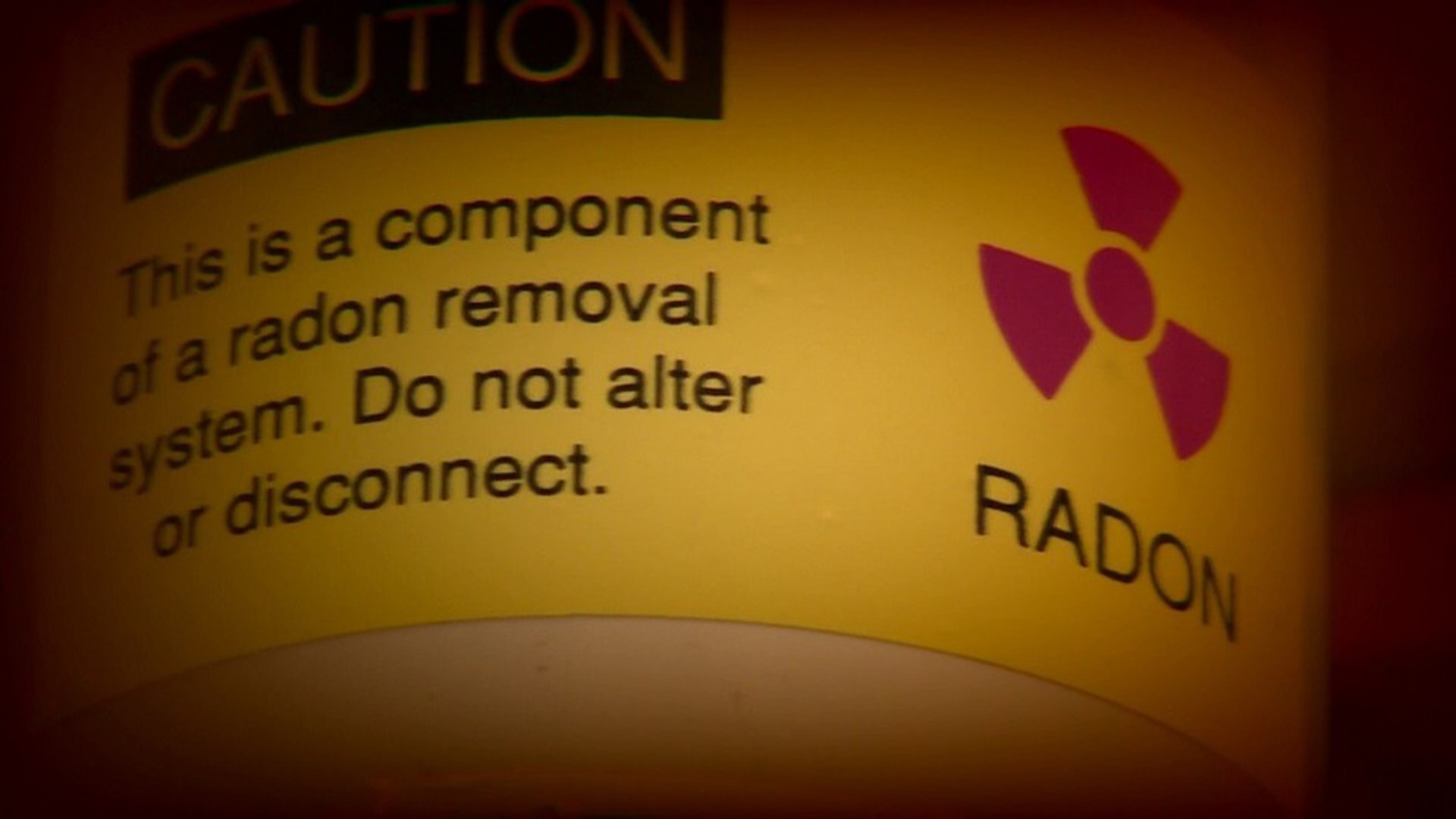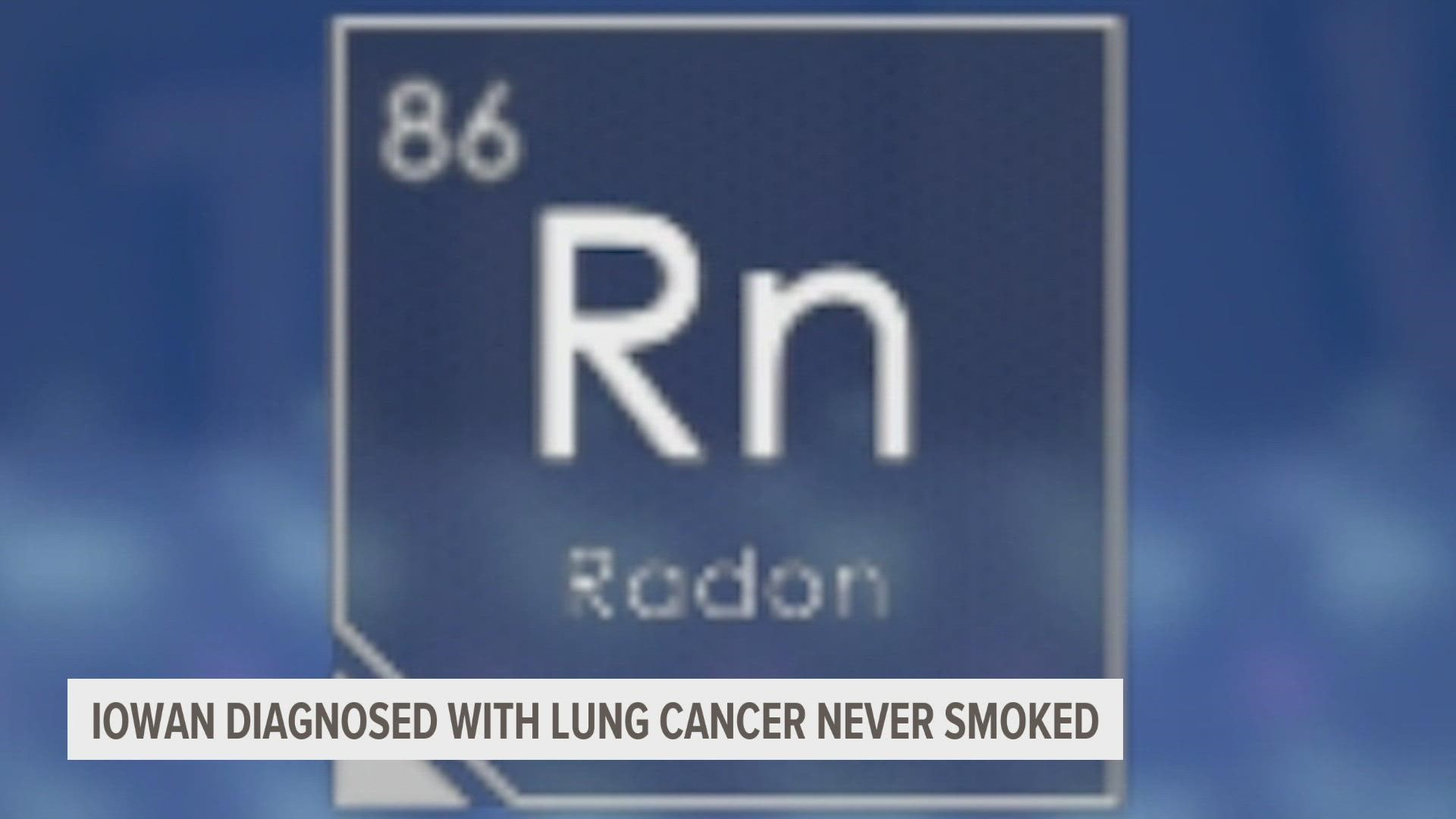The dangers of radon: Protecting yourself in the state with the highest radon concentration
Local 5 spoke with Iowans forever changed by radon, experts dedicated to educating Iowans on its dangers, and state officials working to address the problem.

EDITOR'S NOTE: The above video is from July 13
Iowa has the highest concentrations of radon of any state in the country, according to experts, and that can lead to deadly consequences for those who have never heard of radon and don't know how to protect themselves against it.
Radon is the second leading cause of lung cancer for non-smokers according to the EPA.
Local 5 spoke with Iowans whose lives were forever changed by this toxic gas, experts dedicated to educating Iowans on its dangers and state officials working to address the problem.
Who can be impacted by radon? Local 5 speaks to a cancer survivor
Maria Steele was 62 when she received her diagnosis. One week before Christmas 2019. She had stage four cancer.
She had never touched a cigarette.
"My doctor said the average person with your diagnosis lives a year," Steele said. "I was like, no way. That's not going to be right for me."
As of August, it's been 20 months since the diagnosis. Her medical team suspected radon was the cause. Steele had heard of radon, but had no idea how prevalent it is in Iowa.


"Radon is very common and many people don't know about it," said Dr. Richard Deming, Maria's doctor and the medical director at MercyOne Des Moines Cancer Center.
Deming said radon is the leading cause of lung cancer among non-smokers.
It is a naturally-occurring gas that comes from the ground, and can seep into basements through cracks in the cement. Lung cancer can happen with long-term exposure to radon and unless someone tests for it, there's no telling if it is the cause of illness.


"There's not an acute illness that happens because of inhaling radon," Deming added.
That is why he and Maria are encouraging Iowans to test their homes for the toxic gas. Steele wrote a Des Moines Register op-ed in March, sharing statistics from the Environmental Protection Agency, Iowa Department of Public Health and the American Lung Association.
"There's probably no one in the United States that doesn't know smoking cigarettes causes cancer, but many people are not aware that radon exists and are not aware that they may be inhaling it and that it causes cancer," Deming said.


Since her diagnosis, Steele has found there's a stigma surrounding her condition.
"It's the only cancer diagnosis that you have to defend," she said." Somebody would say to me, 'I didn't know you smoked.' I never smoked."
She doesn't let it get her down, staying active cycling across Iowa and chronicling her experiences on her blog, Aging With Energy. She also participated in the American Lung Association 2021 Fight for Air Climb in May.
"Why have a pity party? No one's going to show up."
Why are radon levels so high in Iowa? Local 5 speaks to the expert
Iowa is designated a "Zone One" state by the EPA, meaning at least 50% of homes have radon levels above what is considered safe. An Iowa radon survey conducted by the Iowa Department of Public Health found 71.6% of Iowa homes have high levels of radon.
Below is a map of radon levels across the U.S. from the EPA.
"In Iowa, we have the highest radon concentrations in the nation," said Dr. Bill Field, an internationally acclaimed radon expert at the University of Iowa College of Public Health.
Field coordinated a series of studies in the 1990s that helped identify radon as a leading cause of lung cancer among non-smokers. He shared his findings, pooled his data with that of other studies on radon and helped show the world the harm radon can cause.
In 2006, he helped the World Health Organization release new guidance about radon. When it comes to why radon is so prevalent in Iowa, he said the answer can be found beneath our feet.
"It's because of our glacial heritage, Field said. "During the glaciation period millions of years ago, granite rock sheared from the Canadian Shield was transported and deposited in Iowa."
While Minnesota and South Dakota were also impacted by these glacier shifts, Iowa is unique because high levels of radon can be found at high levels not only inside, but outside.
"Outdoor radon concentrations in Iowa, especially northwest parts of Iowa, are equal to what we see for the national indoor average in the US," Field concluded.
He estimates 20 to 30 Iowans die from outdoor exposure to radon alone every year. While exposure is hard to prevent outside, protecting a home is easy, but it's not required by law.
Field said there are regulations in Iowa requiring all licensed day cares to test for radon, but homes, offices, and schools aren't required to test. The EPA estimates 70,000 rooms in schools across the country have high short-term radon levels.
"We really have to look at schools next," Field told Local 5.
Advocating for radon testing in Iowa schools Local 5 speaks to lawmakers and advocates
There is a bill at the state house that would mandate all public schools in Iowa to test for radon, but one of its biggest advocates didn't live to see if it would ever become law.
Gail Orcutt lost her 10-year battle with radon-induced lung cancer in 2020. Her husband, Bill Orcutt, told Local 5 they received the diagnosis on May 6, 2010, one day before her birthday.
"We were devastated," Bill said. "I felt a shock that went from the top of my head to the base of my spine when the doctor said it was cancer."


It was also the same day they first learned about radon. Radon took one of her lungs, but not her spirit.
Over the next 10 years, Gail made it her mission to raise awareness whether it was chatting with people in line at the cash register or in the chambers of the Iowa House.
"Gail came to the legislature for years educating us," State Rep. Art Staed, D-Cedar Rapids.
The state lawmaker from was inspired by her advocacy and worked with her to craft a bill to mandate all public schools in Iowa test for radon. The bill is House File 243.
It has never passed the House, or even made it to the floor for a vote.
"I'm going to introduce it or one like it every year until it gets passed," Staed said.
Gail's mission also attracted national attention to the issue, appearing on NBC's "Today Show", where she was interviewed about her diagnosis and her advocacy. She also inspired nonprofits like the Energy Association of Iowa Schools to step in where laws were falling short.
Julie Weisshaar, executive director of EAIS, first met Gail at a Region Seven EPA radon meeting.
"I really wanted to talk with her and learn from her knowing that she had been a teacher for 33 years," Weisshaar said.


EAIS's mission is to help schools practice environmental sustainability and protect students. The group has helped 53 school districts in Iowa test 213 buildings for radon.
Before Gail's death, she and her husband established the Orcutt Radon Reduction Foundation Fund. Instead of flowers, her obituary urged mourners to donate.
Bill hopes by next year, it has enough money to buy radon mitigation systems for at least 10 homeowners in Iowa. When he passes away and their home is sold, the money from the sale will go to the foundation. It's a legacy he hopes will outlive them both.
Click here for the link to donate.
Local 5 reached out to school districts in the metro to see how many test for radon.
Here's what they had to say:
Des Moines Public Schools
The district has an entire webpage dedicated to explaining their radon testing and mitigation to parents. DMPS began testing for radon in 2011. In 2014, DMPS began following guidance released from the American National Standards Institute (ANSI) and the American Association of Radon Scientists and Technologists (AARST).
Click here to see those guidelines.
Radon testing is done on a revolving five-year schedule according to their webpage. From 2021 to 2022, the district will be testing the following buildings:
- Capital View
- Central Academy
- Central Campus
- Cowles
- Edmunds
- Greenwood
- Harding
- Hillis
- Howe
- Hubbell
- Madison
- Park Avenue
- 1915 Prospect
- Roosevelt
- Smouse
- Stowe
- Windsor
Click here to find the district's full schedule for radon testing. DMPS also keeps a record of those test results for public viewing.
Click here to view those results.
West Des Moines Community Schools
The district tests all facilities every five years for radon, according to Christine Maduro, director of operations. Buildings will be tested this year.
Maduro said only one mitigation system was installed at a district building, Western Hills Elementary.
Ankeny Community School District
The last time the district had classrooms tested was in November 2019, according to a statement sent to Local 5. No results required mitigation.
The district said the last time a mitigation system was installed was in 2014 at a building used for community engagement activities.
Urbandale Community School District
Urbandale Community School District released a statement saying it regularly tests radon levels in its buildings. If the district ever gets a reading above four pCi/L, it said a vial test would be performed to verify.
So far, the district said no spaces tested close to four pCi/L.
Johnston Community School District
The district said in a statement radon testing was performed in every classroom and building in 2020. All returned "satisfactory" results.
The district said it will test again in another five years unless certain conditions are met that are spelled out in the testing company’s recommendations or Iowa Department of Public Health radon (re)testing guidelines:
- If no mitigation is required after initial testing (e.g., all rooms were found to have levels below four pCi/L), retest all frequently occupied rooms in contact with the ground every five years. As a building ages and settles, radon entry may increase due to cracks in the foundation or other structural changes.
- If radon mitigation measures have been implemented in a school, retest these systems as a periodic check on any implemented radon reduction measures.
- If major renovations to the structure of a school building or major alterations to a school's HVAC system are planned, retest the school before initiating the renovation. If elevated radon is present, radon-resistant techniques can be included as part of the renovation.
- Retest after major renovations to the structure of a school building or after major alterations to a school's HVAC system. These renovations and alterations may increase radon levels within a school building.
Southeast Polk Community School District
In a statement, the district said school buildings are tested for radon.
Communities making their own radon rules
Where state law falls short, communities in Iowa are enacting their own policies to protect residents from radon.
Some cities and counties have building codes requiring new homes to be built with radon-resistant construction practices.
According to the Iowa Department of Public Health, those communities include:
Cities
- Altoona
- Bondurant
- Burlington
- Coralville
- Ely
- Harlan
- Hiawatha
- Iowa City
- Lisbon
- Muscatine
- North Liberty
- Oxford
Counties
- Adair
- Audobon
- Cass
- Greene
- Guthrie
- Johnson
- Linn
- Muscatine
- Polk
- Shelby
Iowa City goes a step further, requiring landlords of single-family and duplex rental units to test for radon and mitigate if levels are above four picocuries per liter (pCi/L) .
How to reduce radon in your home Local 5 speaks to radon mitigation experts
Reducing the risk of radon-induced lung cancer starts with testing your home.
According to Dan Weber, a mitigation expert from Central Iowa Radon, no two homes have the same risk.
"You can have two homes right next to each other and one can test low and one can high for radon," Weber said.
While Weber has seen a rise in business over the years as more people become aware of the dangers of radon, there is still a lot of misinformation out there.
"A lot of people have the misconception that radon comes in and stays in the basement," Weber said. "Unfortunately, a lot of HVAC equipment is in the basement, so that can spread radon from the basement to the first and second floors."
There are two options for radon testing: calling a professional like Weber, or doing it yourself.
An expert will come in with a radon detector that will stay in a home for 48 hours, taking hourly readings and show the results at the end of that timeframe. Doing it yourself requires buying an at-home radon testing kit that can be found at any hardware store.
The big difference is the wait time.
"Home test kits have to be sent to a lab, so they can take a little longer to get the results back," Weber said.
According to the EPA, radon levels under two pCi/L don't require mitigation. If levels are between two and four pCi/L, the EPA recommends considering installing a radon mitigation system.
If levels are above four pCi/L, the EPA urges you to install a mitigation system.
Weber said mitigation systems pull radon out of the basement and push it out of the house through a pipe. They can cost anywhere from $1,200 to $1,500 dollars and take about five to six hours to install.
Radon and real estate market Local 5 speaks with a realtor
One of the most common times people test for radon or install a mitigation system is during the home buying process. Because the pandemic is causing an unusually hot housing market, those trends are changing.
"Everything is a negotiation," said Jen Burkamper, President of the Iowa Association of Realtors, "Because buyers are competing against multiple offers, they're going to write the cleanest offer."
In the past, Burkamper said it was common for sellers and buyers to include a radon mitigation system installation into the home-buying negotiations. During 2021's hot housing market, however, Burkamper advises buyers who care about radon mitigation should plan to install a mitigation system after closing the deal.
Trying to negotiate with the seller to pay for part of the installation is a risky move if you're competing against multiple offers.
Sellers are required to disclose if the home has recently been tested for radon and if so, they also have to disclose the results of the test.


